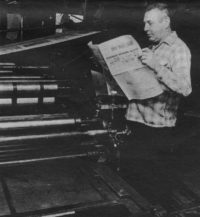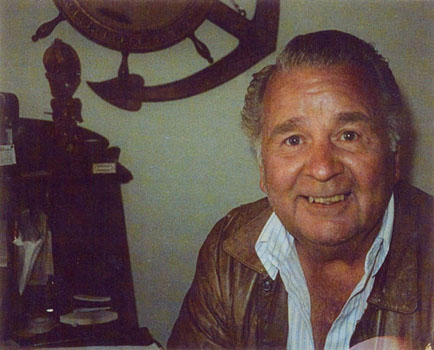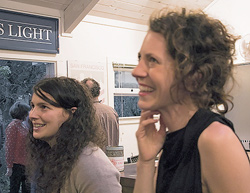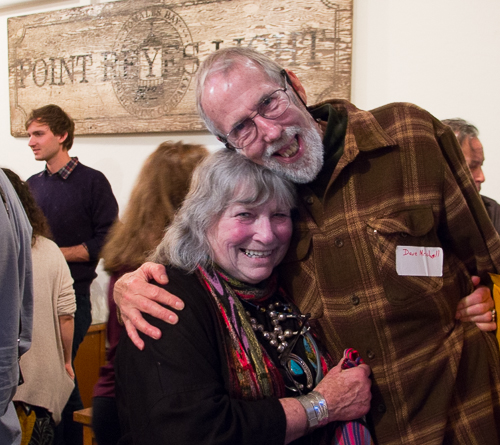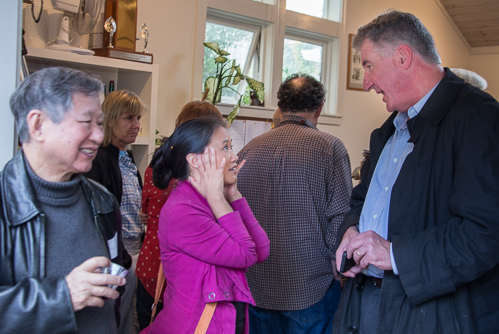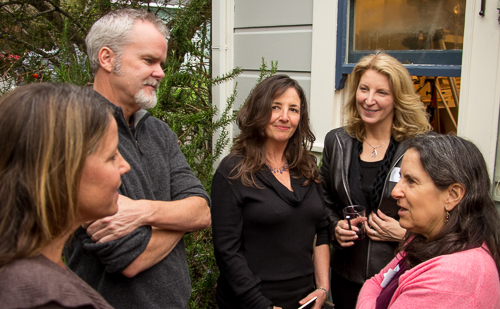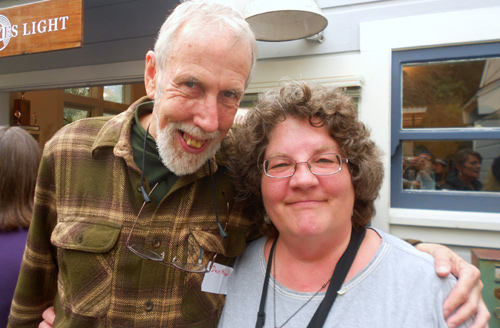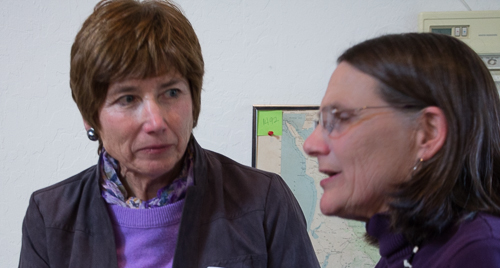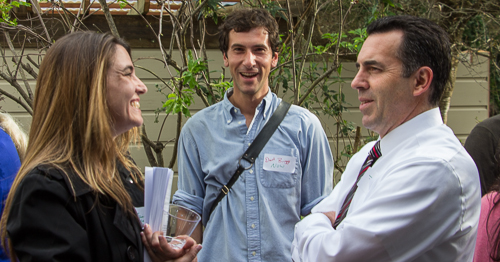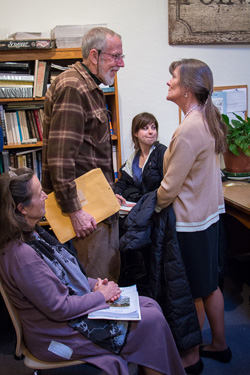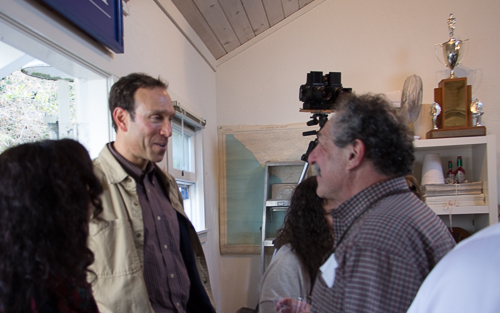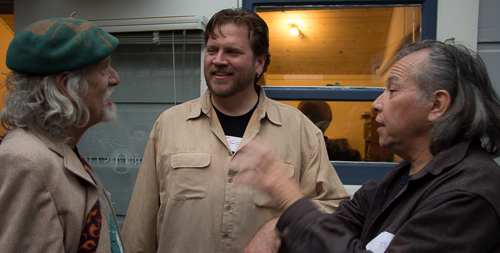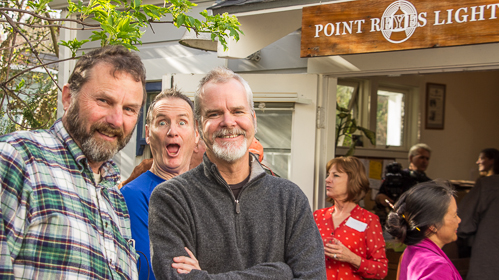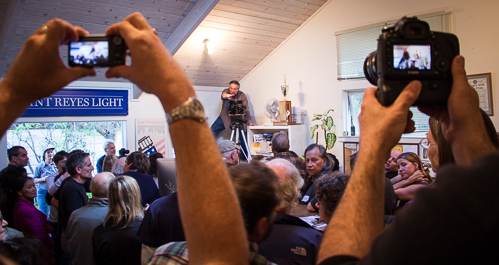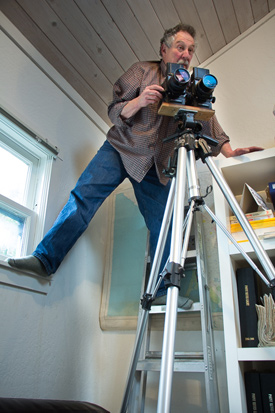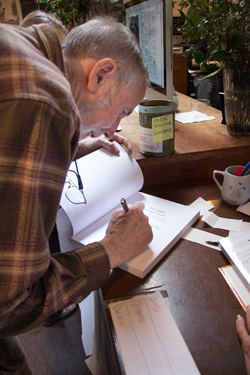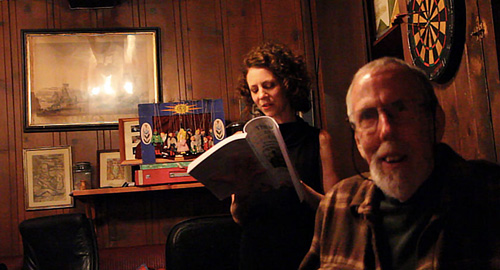Entries tagged with “Don DeWolfe”.
Did you find what you wanted?
Fri 15 May 2020
Posted by DavidMitchell under History, Point Reyes Station, The Point Reyes Light Newspaper
Comments Off on We’re going to miss the Station House Café
News that the Station House Café in Point Reyes Station will close at the end of this month has shocked many of us in West Marin and has generated newspaper and TV attention throughout the San Francisco Bay Area. Owner Sheryl Cahill says the new owner of the restaurant building wants to up the rent to approximately $700 per day, which she can’t afford. She hopes she can eventually reopen somewhere else.
For years while I edited and published The Point Reyes Light, I ate breakfast there almost daily and often used my mealtime to also pick up news tips, so I’m particularly chagrined by the upcoming closure. In fact, the newspaper and the restaurant have been associated in various ways for more than 50 years, beginning when the paper was published by Don DeWolfe and called The Baywood Press. Back then, the restaurant, which was located where Osteria Stellina is today, was operated by historian Jack Mason of Inverness, a retired Oakland Tribune editor.
Mason, who bought the restaurant in 1966, also wrote Funny Old World for DeWolfe’s paper, and years later in the same column, he described what the restaurant and DeWolfe were like back then. The column was reprinted in our 2013 book, The Light on the Coast. In case you missed it, here it is again:
By Jack Mason
“I’ve got an idea,” Don DeWolfe said.
I laid his medium-rare hamburger on the counter in front of him. “If so, it’s the first time,” I said, in the kidding tone one uses with an old friend, even if he is the local editor.
He didn’t bother to parry the thrust, but handed me a mustard container he had been fiddling with. “This one’s empty,” he said.
I gave him another from under the counter.
“What’s your idea?” I said. My interest was only lukewarm. Certainly I was not flattered that he would ask me for my opinion. Editors do that, ask everybody in the place what they think, then do their own thing regardless. It’s the way Great Battles have been fought and lost since the dawn of time.
He squeezed some of the brown stuff onto his hamburger patty, then pressed down hard on the bun as if afraid the meat might get away. Those were quarter-pound hamburgers I served at the Station House in 1966, and the buns all had sesame seeds on top.
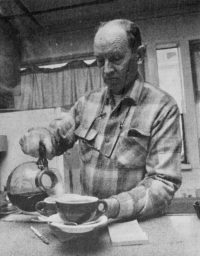
Jack Mason as owner of the Station House Café in 1967.
“The coffee will be ready in a minute,” I said. “We had a couple of customers in here awhile back, and they drank it like it was going out of style.”
“You mean you have other customers?” Don exclaimed. He dug into his burger, reaching for a napkin. “This napkin holder is empty,” he said.
I pushed one towards him from further down the counter, just as the phone rang. “Probably Willi Reinhardt,” I said. “The toilets are plugged up. That ought to take care of your crack about other customers!”
But it was Bob Vilas at the bank. “Jack,” he said, “these checks you wrote Farmer Brothers and Schwartz’s Meat Company last week. What do you expect me to do with them?”
In red-faced confusion, I told Bob it was good of him to call, and said I would be right over to take care of it, as soon as I got rid of my customer.
“You have a customer?”
“Yeah, Don DeWolfe.”

Standing beside his printing press, DeWolfe in 1967 looks over his recently renamed newspaper. Back then the newspaper was produced in the building where Rob Janes Tax Service, Coastal Marin Real Estate, and Epicenter clothing boutique are today.
“Well, tell Don for me, will you, that I think his new idea is great!”
I was really taken aback. “You mean he’s tried the idea out on you? What is it?”
“You don’t know?” Bob cried. “I thought everybody on the street was in on it.”
I hung up, stung, and stood there for a moment letting my anger cool. Here I’d been writing a column for DeWolfe, free. Writing editorials in my spare time, absolutely free of charge! And I’m the last one on the street to know about this great, world-shaking idea of his!
“What is it? I mean, your idea?” I demanded.
He was wiping his hands on four paper napkins at once. Finally he rolled them up into one big ball and dropped them in the green hamburger basket.
“Oh,” he said. “The idea.”
“Yeah, you’ve told everybody else. How about telling old Jack?”
He worked his way off the stool, and pulled some small change out of his pocket, and I mean small. “How much is a hamburger?”
“Did you have cheese on it?”
“No, I can’t eat cheese.”
“Fifty cents. And don’t bother to leave a tip.” I dropped his five dimes and three pennies in the cash drawer. The spring was broken, so we always left the drawer open.
“My idea,” he said, “is to change the name of the paper.”
I felt let down. “What’s wrong with The Baywood Press. It’s been called that for 16 years. It has tradition behind it. People are used to it. Why change it?”
“I thought Point Reyes Light would tie in better with the area,” he said. He inspected me momentarily for my reaction. “I’ll think it over,” I said.
He had to bring all his weight to bear against the door before he could let himself out; the pneumatic catch was stuck. Then he stood there a moment screwing his mouth into an odd shape.
“This is the only hamburger joint I was ever in,” he said, “that didn’t have toothpicks by the cash register.”
The name Baywood Press was changed to Point Reyes Light with the issue of September 8, 1966.
March 2, 1978
The next posting on SparselySageAndTimely.com will reminisce about the restaurant in more recent times.
Sun 23 Oct 2016
Posted by DavidMitchell under History
[2] Comments
Don DeWolfe, who died in 1987, published The Point Reyes Light/Baywood Press from 1957 to 1970 in what is now the Coastal Marin Real Estate building. He wrote the first part of this Bob Worthington retrospective as a column for the Jan. 19, 1984, issue.
By Don DeWolfe
Former resident Bob Worthington was in town. Bob built a number of homes here. The first was George DeMartini’s home on Highway 1 north of the school.
Worthington (seen below in 1970), died in 2001. He was a World War II vet with a Purple Heart, as well as a former contractor, prison guard, and police informer.
He built a cluster of homes on the Mesa, including his own, which is now owned by [Krauth Brand].

He also built the apartment house on Mesa Road behind The Point Reyes Light building.
Worthington bought the lot from Burt Jensen, who owned Sunbeam Motors, and had it surveyed. [Sunbeam Motors was located on the main street where Cheda’s Garage is today.]
Through the years as the county road crew replaced the blacktop on Mesa Road, they had rounded out the corner so much that the corner of Bob’s lot was now right in the center of the road. He took a pick and dug a hole in the blacktop at that spot. Sure enough, he found the old surveyor’s monument, and Bob needed every square foot of the lot for his building [to have enough setback from the road] to qualify for a building permit.

On a Friday afternoon from the back window at my printing shop at The Light, I saw Bob appear, along with Walt Kantala and his backhoe.”
Don DeWolfe (right) pretending to type a column at the bar in the Old Western Saloon, which he frequented.
“Walt proceeded to tear the blacktop off the road. I walked back and said, ‘Bob, you’re fixing to get into a heap of trouble. You can’t just tear up the county road.’
“‘The hell I can’t,’ he replied. ‘It’s on my property.’
“‘But, Bob,’ I explained, ‘By right of eminent domain the county is going to claim they now own the road part of the lot.’
“‘Look, Don,’ he said. ‘It’s Friday afternoon. All the big wigs at Civic Center have already left for the weekend. By Monday morning, I’ll have the forms all in and be ready to pour the foundation.'”

When I first came to Point Reyes Station in 1975, the fence to the right of the tree had not yet been erected, and more than a few inattentive motorists drove over the then-small sapling, usually breaking a bunch of limbs.
Monday morning came, and so did the county. After a few words they departed. Next morning the road crew appeared and moved the road back over where it belonged. Bob built a monument on the corner and planted a tree in it.
Later Bob did some remodeling for Sally Stanford at her San Francisco home. [Sally Stanford had been a brothel madam in San Francisco and later opened the Valhalla restaurant in Sausalito, where she was elected to the city council and became mayor.]

One night on the way home Bob stopped at a bar in Sausalito for a drink. He overheard a couple of guys at the bar plotting to break into Sally’s home while she was away and steal her valuable jewelry. He tipped off the police, who put a stakeout on the place. A couple of nights later they nabbed the two guys trying to break in.
Later someone fired a shot at Bob while he was driving along the road at Nicasio. The bullet went through the open window of his pickup right in front of his face and out the closed window on the other side. So Bob moved away.
Sally Stanford in 1947
_________
At this point, San Francisco Chronicle reporter Ralph Craib picks up the story. In a Nov. 4, 1966, report, ‘Good Citizen Pays High Price,’ Craib described the many ways criminals exacted revenge on Bob Worthington for his informing the police about the impending burglary. Here are some excerpts from the article. By coincidence, Craib, who died in 1995, was the reporter who nominated The Point Reyes Light for its 1979 Pulitzer Prize for Public Service.
By Ralph Craib
“An armed but frightened man recited yesterday the harrowing personal price he has paid since serving as a police informer.
“His [contracting] business is dead; he has been ambushed and shot, and his wife and two children live in constant fear and almost continuously on the move, said one-time San Quentin guard Robert Worthington.
“Worthington provided police with their first tip of the impending burglary of the home of Sally Stanford at 2324 Pacific Avenue in April of last year [1965]. Police Officer Salvatore Polani and three others were later convicted after falling into a trap which Worthington, then a Point Reyes contractor, helped set.

“Once his identity was revealed, he said, police were immediately assigned to guard him, his wife, and his daughter, 13, and son, 11.
“But his business began falling apart. He couldn’t go out to a lot to inspect a prospective building site, he said, until police had checked out the person he was to meet. He had to have his telephone disconnected because of ominous calls received by his wife.”
Ralph Craib (right) celebrates with Cathy Mitchell and me in the Point Reyes Light’s newsroom on April 16, 1979. She and I had just learned that, thanks to Craib’s nomination, our little weekly newspaper had won the 1979 Pulitzer Prize for Public Service.
“He has moved his family home five times and has had to send his family out of town on several occasions when police warned him that there was danger. Two cars he owned have been repossessed. Three homes which he had built and in which he had substantial investment have been foreclosed.
“‘On a couple of occasions, I was followed by strange cars,” Worthington said. “‘One night I was followed by a car without lights and went up to 100 miles an hour. At night time you can’t see back and the only thing to do is run.’
“Worthington was provided a gun by police and used it once. He was ambushed on Lucas Valley Road in Marin County, Sept. 5, 1966, and grazed by a bullet. He fired two shots back at his attackers.”
____________________
In 1999, Bob Worthington belatedly received a Purple Heart, having suffered PTSD and having developed a serious heart condition while fighting on Guadalcanal in World War II. He died in 2001 in Coos Bay, Oregon, at the age of 76.
Tue 4 Mar 2014
During an open house and reunion Saturday, a happy throng of Point Reyes Light readers, staff, and columnists joined with former staff and correspondents to celebrate the 66th anniversary of the newspaper’s first issue. 
The reunion drew staff and contributors who had worked at the paper at different times during the past 44 years. A number of former staff traveled hundreds of miles to attend. A couple of them arrived from out of state.
From left: Laura Lee Miller, David Rolland (who drove up from San Diego), Cat Cowles, Wendi Kallins, Janine Warner (who drove up from Los Angeles), Elisabeth Ptak (back to camera), Gayanne Enquist, Art Rogers (talking with Elisabeth), Keith Ervin (who drove down from Seattle), B.G. Buttemiller, and (in blue shirt with back to camera) Victor Reyes. (Photo by Dave LaFontaine) ______________________________________________________________
 The party was also a celebration of the Tomales Regional History Center’s publishing The Light on the Coast: 65 Years of News Big and Small as Reported in The Point Reyes Light.
The party was also a celebration of the Tomales Regional History Center’s publishing The Light on the Coast: 65 Years of News Big and Small as Reported in The Point Reyes Light.
Stuart Chapman of Bolinas, a former member of the staff, shot this photo, which he titled “Dave, Proud Father” because I authored the book.
My co-author was Jacoba Charles. Jacoba reported for The Light under its previous ownership and is a member of the paper’s board of directors under its present ownership, Marin Media Institute.
The colored Post-its, by the way, mark selections that I, along with others, would be reading to attendees. ____________________________________________________________

From left: Co-author Jacoba Charles, photographer Art Rogers, scientist Corey Goodman, photographer David Briggs, editorial consultant on the book and former member of The Light’s ad department Lynn Axelrod, and Spanish-language columnist Victor Reyes. (Except where noted otherwise, the photos in this posting were shot by former Light reporter Janine Warner)

Michael Gahagan (left), who drove down from the Sierra Nevada town of Columbia to attend, published The Light from 1970 to 1975. Here he reminisces with historian Dewey Livingston of Inverness. Dewey for many years provided a weekly historical feature titled “West Marin’s Past.”

During the Gahagan years, Lee Sims (left) was the newspaper’s main typographer. This was back in the days before offset printing, and each page that went on the press had to be composed in lead.
In a piece written for The Light’s 30th anniversary in 1978 and reprinted in The Light on the Coast, Michael Gahagan’s former wife Annabelle comments, “Poor Lee, he had the disadvantage of being a friend of ours. One can always depend on friends, and we did lean on him! He was always underpaid and overworked. (Weren’t we all?)”

Catching up on old times are (in foreground from left): former news editor David Rolland, who drove to the reunion from San Diego, former typesetter Cat Cowles of Inverness, and former reporter Joel Reese, who flew in from Chicago. Standing behind them are current reporter Christopher Peak (left) and Matt Gallagher, who filled in as managing editor from February through July 2011. _____________________________________________________________
 Samantha Kimmey (on the left) has been a reporter at The Light for the past year. With her is Tess Elliott of Inverness, who has been The Light’s editor for the past eight year. ____________________________________________________________
Samantha Kimmey (on the left) has been a reporter at The Light for the past year. With her is Tess Elliott of Inverness, who has been The Light’s editor for the past eight year. ____________________________________________________________

Gayanne Enquist was office manager during much of the 27 years I owned The Light. She was there when I arrived in July 1975, and she was there when I left in November 2005. (I was away reporting for the old San Francisco Examiner between September 1981 and the end of 1983.)

Former reporter Michelle Ling trades stories with Don Schinske, who was business manager during the 1990s and was co-publisher from 1995 to 1998. At left is her father, Dr. Walter Ling who teaches at UCLA. With his wife, May, Dr. Ling drove to Point Reyes Station for the celebration. In the background, Mary Papale listens intently to Laura Rogers.

Ingrid Noyes of Marshall (left) tells a story to my co-author, Jacoba Charles, outside The Light office.

Former staff recall the days of yore. From left: artist Laura Lee Miller, news editor David Rolland, typesetter Cat Cowles, reporter Janine Warner, and San Geronimo Valley correspondent Wendi Kallins. (Photo by Dave LaFontaine)

Sarah Rohrs was a reporter at The Light in the late 1980s. When several of us took turns reading aloud selections from The Light on the Coast, I read Sarah’s wonderfully droll account of a county fireman in Hicks Valley having to get a cow down out of a tree. (Photo by Joe Gramer)

Larken Bradley (left), who formerly wrote obituaries for The Light, chats with librarian Kerry Livingston, wife of Dewey.

Photographer Janine Dunn née Collins in 1995 traveled with news editor David Rolland to Switzerland’s Italian-speaking Canton of Ticino and to war-torn Croatia in doing research for The Light’s series on the five waves of historic immigration to West Marin. Here she chats with the paper’s current photographer David Briggs (center) and her husband John Dunn.

Former Light graphic artist Kathleen O’Neill (left) discusses newspapering in West Marin with present business manager Diana Cameron. _____________________________________________________________
 Former Light reporter Marian Schinske (right) and I wax nostalgic while photographic contributor Ilka Hartmann (left), looks on and Heather Mack (center), a graduate student in Journalism at UC Berkeley, takes notes. ____________________________________________________________
Former Light reporter Marian Schinske (right) and I wax nostalgic while photographic contributor Ilka Hartmann (left), looks on and Heather Mack (center), a graduate student in Journalism at UC Berkeley, takes notes. ____________________________________________________________

Former news editor Jim Kravets (left) jokes with photographer Art Rogers.

John Hulls of Point Reyes Station and Cynthia Clark of Novato have in the past worked with The Light in various capacities. In 1984, Cynthia set up the first computer system for the newsroom and ad department.

From left: Stuart Chapman of Bolinas, who formerly worked in The Light’s ad department, swaps stories with journalist Dave LaFontaine of Los Angeles and Light columnist Victor Reyes.

Historian Dewey Livingston (left), a former production manager at The Light, poses with former news editor David Rolland while former business manager Bert Crews of Tomales mugs in the background.

In preparing to shoot one of his signature group portraits, Art Rogers directs members of the crowd where to stand. With the throng crowded into the newspaper office, getting everyone in the right place to be seen was such a complicated operation that some of the photographer’s subjects began photographing him. _____________________________________________________________
 In shooting a series of three-dimensional photos, Art had to use a tall tripod and balance precariously on a window ledge and ladder. _____________________________________________________________
In shooting a series of three-dimensional photos, Art had to use a tall tripod and balance precariously on a window ledge and ladder. _____________________________________________________________

Art’s wife, Laura, who didn’t have to work nearly as hard, pages through a copy of The Light on the Coast. _______________________________________________________________
 The party was in part a book-signing, and I signed copies off and on all afternoon. ______________________________________________________
The party was in part a book-signing, and I signed copies off and on all afternoon. ______________________________________________________

Light editor Tess Elliott reads Wilma Van Peer’s 1998 account of working for the paper’s founders, Dave and Wilma Rogers half a century earlier. The newspaper was called The Baywood Press when it began publishing in 1948. The paper’s fourth publisher, Don DeWolfe, changed the name to Point Reyes Light in 1966.
Originally the readings were scheduled to be held in the newspaper office, but so much socializing was going on they had to be delayed until the party moved around the corner to Vladimir’s Czech Restaurant where the banquet room had been reserved.
Among those reading besides Tess were Dewey Livingston, David Rolland, Matt Gallagher, and I. Anyone wishing to watch me read former publisher (1957 to 1970) Don DeWolfe’s account of his initiation to running the paper can click here.
It was a grand party, and I want to thank present Light staff, who made arrangements for the party, and former staff, some of whom traveled significant distances to attend the reunion.
Two other book readings are also scheduled. At 3 p.m. Sunday, March 9, in Point Reyes Presbyterian Church, Point Reyes Books will sponsor readings from The Light on the Coast and from Point Reyes Sheriff’s Calls, Susanna Solomon’s book of short stories inspired by Sheriff’s Calls in The Light.
At 4 p.m. Sunday, April 27, in its Corte Madera store, Book Passage will sponsor readings from The Light on the Coast. Refreshments will be served.
Tags: Art Rogers, B.G. Buttemiller, Baywood Press, Bert Crews, Cat Cowles, Christopher Peak, Corey Goodman, Cynthia Clark, Dave LaFontaine, Dave Rogers, David Briggs, David Rolland, Dewey Livingston, Diana Cameron, Don DeWolfe, Don Schinske, Elisabeth Ptak, Gayanne Enquist, Heather Merk, Ilka Hartmann, Jacoba Charles, Janine Dunn née Collins, Janine Warner, Jim Kravetz, John Dunn, John Hulls, Kathleen O'Neill, Keith Ervin, Kerry Livingston, Larken Bradley, Laura Lee Miller, Laura Rogers, Lee Sims, Marian Schinske, Matt Gallagher, Michael Gahagan, Point Reyes Light, Sarah Rohrs, Stuart Chapman, Tess Elliott, The Light on the Coast, VÃctor Reyes, Wendi Kallins

